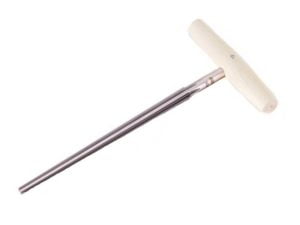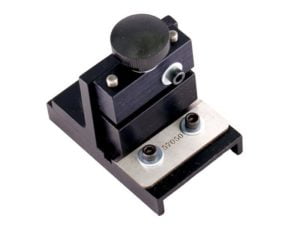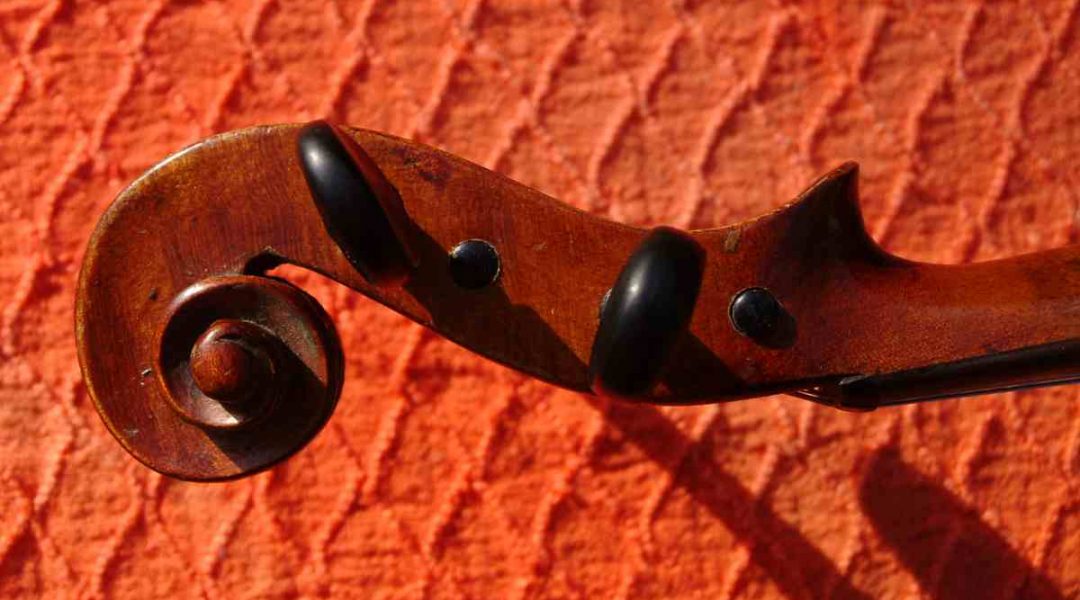Originally posted 2013-06-27 22:56:04.
To replace a peg, you’ll need the right tools.
Some of these are specialised, and can be expensive, but even after just one set of pegs, you’ll be ahead, and believe me, then you’ll want to do more.
One of the most common problems with old violins is that the pegs are poorly fitted, are not a match to the violin or are just plain old worn out. A fiddle that won’t tune because the pegs jam or slip is a curse. Fitting new pegs is not difficult to do.
This is one of the tasks that definitely requires special tools, and please do not be tempted to try to get round this, as you are very likely to damage both the pegs and the violin if you do.
Most modern pegs are ebony, which is very hard-wearing, but many older fiddles, even rather nice ones, had rosewood or maple pegs. These are still produced and can be very attractive, but today they are normally left unfinished, in the natural colour of the wood. In former times they were usually “ebonised” or in other words painted (japanned) with black, or Japanese, lacquer, which is a very hard, black coating.
This is not in itself a bad thing, and if the pegs are in good condition you need do nothing but give them a good clean and perhaps apply some peg-soap if they tend to bind. More likely, though, the tapers on the pegs will be uneven with shoulders where the pegs pass through the peg-box walls. They may also no longer be concentric or warped as the wood has distorted with age, and the holes in the peg-box themselves may be misshapen. Indeed it is not unheard-of for non-original, non-matching and definitely non-fitted pegs to be jammed into an old fiddle by an unscrupulous dealer just to get it sold! If any of these problems are manifest, or if cleaning does not make the pegs behave, then you should replace them all as a set.
Tools Required:
Peg-hole Reamer
Peg Shaver
Razor saw
Files
Emery paper (400)
Vee-block (home-made)
Drill with 1/16inch bit
Materials
One set “finished” (pre-tapered) pegs
Reaming out the Peg-Box

The modern standard for the taper of a tuning peg is 30:1. If you are replacing old pegs, you will most probably find that their taper is steeper than this, and the peg-box holes may well be deformed.
If you can re-use the old pegs, so much the better, but on every old violin I have worked on, once the peg-holes were reamed true, there was not enough wood left on the original pegs to let them be trued and used again. If the pegs are well worn or are not a set, then they should be replaced. And if they are missing altogether, which is not unusual, you will have to!
Firstly, you must ream out the holes so that they are actually circular, concentric, and of the correct taper. Peg-hole reamers come in two types, plain and spiral. Professionals like the spiral type but I strongly advise you to buy the plain. In this the cutting flutes are parallel with the axis of the reamer, whereas in the spiral or helical type they wind down the length of the reamer like a screw. The danger with these is that it’s very easy to cut too deeply, the advantage is that it is easier to control the tool when using the reamer in reverse to compress the wood of the peg-box walls. However the peril of cutting too much wood is more of an issue, and in any case plain reamers are much cheaper.
Begin by removing the old pegs, if present, and setting them aside. If the violin is very old you should keep these with it, as they are part of its history. Support the body of the violin on a cushion on your lap or the bench and support the far side of the peg-box in your left hand, if you are right-handed, or vice versa. Take the reamer, which is fitted with a T-handle, and insert it into the first hole. Allow the tool to pass between two fingers of your left hand so the peg-box is properly supported. Be careful not to cut yourself. Supporting the peg-box with your hand in this way will also help ensure that you work gently. Without applying pressure to the handle of the reamer, begin to cut. The tool should not be allowed to “chatter” but it should cut under its own weight. DO NOT PUSH!
The tool cuts when turned clockwise. Make one or two full turns, no more, and then remove the tool with a slight anti-clockwise twisting motion and inspect the cut edges. If the edge is showing clean, cut wood for the whole thickness of the wall and right around the circumference, on both sides of the peg-box, DO NOT CUT ANY MORE. If there is still uncut wood showing, repeat the process. As soon as clean, cut wood is visible all round, re-insert the reamer and this time, turn it anticlockwise while applying moderate pressure. Be warned that the presence of a T-handle on the tool means that much more pressure can be applied than when fitting a tuning peg and there is a risk of splitting the wood of the peg-box, which is not a good idea.
Compressing the Wood
This action is to compress the wood. This would eventually happen naturally under pressure from the pegs, but doing it now means that we can trim the pegs to length as soon as they are fitted. But be very careful as you do this.
Repeat the process on each of the peg-holes in turn.
Shaving the Pegs
Now you must shave the pegs down to fit the holes. NEVER, EVER, ream the holes out to fit the new pegs! This should be obvious if you have plain, un-tapered pegs, but even those pegs that are supplied “finished” are actually oversize, and if you ream the holes out to fit them, the next time the pegs have to be replaced, the peg-box will have to be bushed with new wood. That is definitely an operation for the experienced luthier. In addition, the more wood you remove from the peg-box, the more you weaken it and increase the chance of a crack.
Peg-Shavers

There are various types of peg-shaver, but the easiest one to use is the universal type, which is available from Tone Tech in the UK or Stew-Mac in the US . In principle, it works just like a pencil-sharpener.
This type of shaver has to be adjusted to match the taper of the reamer. Slacken off the adjusting box lock-screw, insert the reamer into the jaws of the machine and wind down the main screw until light resistance is felt. Note that the main screw operates in the opposite direction to what you might expect—turning anti-clockwise tightens its grip and vice versa. Tighten the lock-screw and confirm the angle of the jaws is correct by attempting to wiggle the reamer—it should be gripped in the jaws along its contact length. SLACKEN THE MAIN SCREW, then remove the reamer.
Insert the first peg up to the lip, being sure not to push it in too far. Lightly tighten the main screw and begin to turn the peg. One and a half or two turns at the most, then reverse the motion to clear the waste. The tool should only be just tight enough to cut lightly and evenly, and the peg should not be hard to turn. Take your time. Each time you clear the tool, try the peg in the hole. You want a good ¾ inch (20mm) of shaft protruding when the peg is pushed home finger tight, and rather too much than too little.
Be warned that if you are using plain, un-tapered pegs, getting the initial taper right can be a little tricky with the universal shaving machine. Since “finished” or pre-tapered pegs are no more expensive, buy these instead.
Don’t Mix Them Up!
When you are satisfied, lay the peg on the bench, or better still place it in a numbered card. Repeat the process on the other pegs until all four are done, laying them out in sequence or inserting them in the card. It is very important that you don’t mix them up now.
When done, insert all the pegs into the right holes in the peg-box as firmly as you would a strung peg, and note which is protruding the least. Fit it into the peg-box using the pressure you would use on a strung violin. By all means fit a string if this helps. Measure the free length between the side of the peg-box and the flange on the peg. I like this to be about ½ to 5/8 inches, 12mm to 15mm, but it’s a matter of taste really. If you leave them too long the violin may not fit in its case, if you make ’em too short, you will regret it……Somewhere between these extremes will do. If the peg protrudes too far, lightly shave it, one turn at a time, in the shaving machine, until it is a satisfactory length when pushed well home. When you are happy, remove the other pegs one by one and VERY VERY LIGHTLY shave them in the machine until they all match. Be very careful not to overdo it!
Trimming to Length
Once you have a nice even set of pegs, you need to trim them to length. Ebony does not take a pencil mark well, so carefully mark the peg about 1/32 of an inch (1 millimetre) along the shaft from the point that it protrudes from the peg-box on the side away from its button with either a needle file or your razor saw. Take care not to damage the finish on the violin.
Remove each peg in turn and supporting the peg in the vee-block, trim off the waste with the razor saw. The peg should still be too long, so refit it, and remove more wood with a flat file, little by little regularly checking on the violin, until the cut end is almost flush with the peg-box, and then, for a really professional look, form a very slight dome on the end using the file and emery paper. Do not overdo this bit. Repeat for each one.
Drill for the Strings
You’re almost there! Now you need to drill the holes for the strings. With the pegs in the peg box mark the shafts inside the box 1/8 inch (3mm) from the inside of the wall furthest from the button using a needle file. Leave a reasonable gap between the wood of the peg box and the hole, otherwise as the peg “settles” the string itself may foul the peg-box and prevent the peg from holding properly. If this happens you can drill another hole further up the shank, preferably at right angles to the first, but it’s better not to have to.
Remove the peg and carefully drill through the shank at the mark, remembering that the ebony will tend to split at the far side of the hole, so go easy, and firmly support the far side of the peg with some waste wood for the last little bit of drilling. Personally I like to drill the hole at right angles to the plane of the button, but I don’t think it matters. Finally refit the pegs ready for stringing.
Congratulations!
Now you may have a beer/glass of wine/coffee/ tea/dram. You have just fitted your first set of pegs. You should be proud. Unless you are exceptionally gifted, you will find the pegs “settle” by a sixteenth to an eighth of an inch, and you may wish to trim them to length again later, but other than that, you have done the job.
The German firm Schaller makes a mechanical peg which replaces the wooden peg and offers the kind of tuning stability and smoothness that only a mechanical tuner can. No modification is required to the violin and the Schaller peg can be replaced by wooden pegs at a later date if desired. I have never found them necessary, but I do believe that if you play rock or jazz or other amplified music, especially in conditions that are hot and humid, these might well be worth considering. Just a passing thought. I have occasionally seen fiddles fitted with guitar-type tuning machines, and they really look awful: the Schallers at least look the part.




